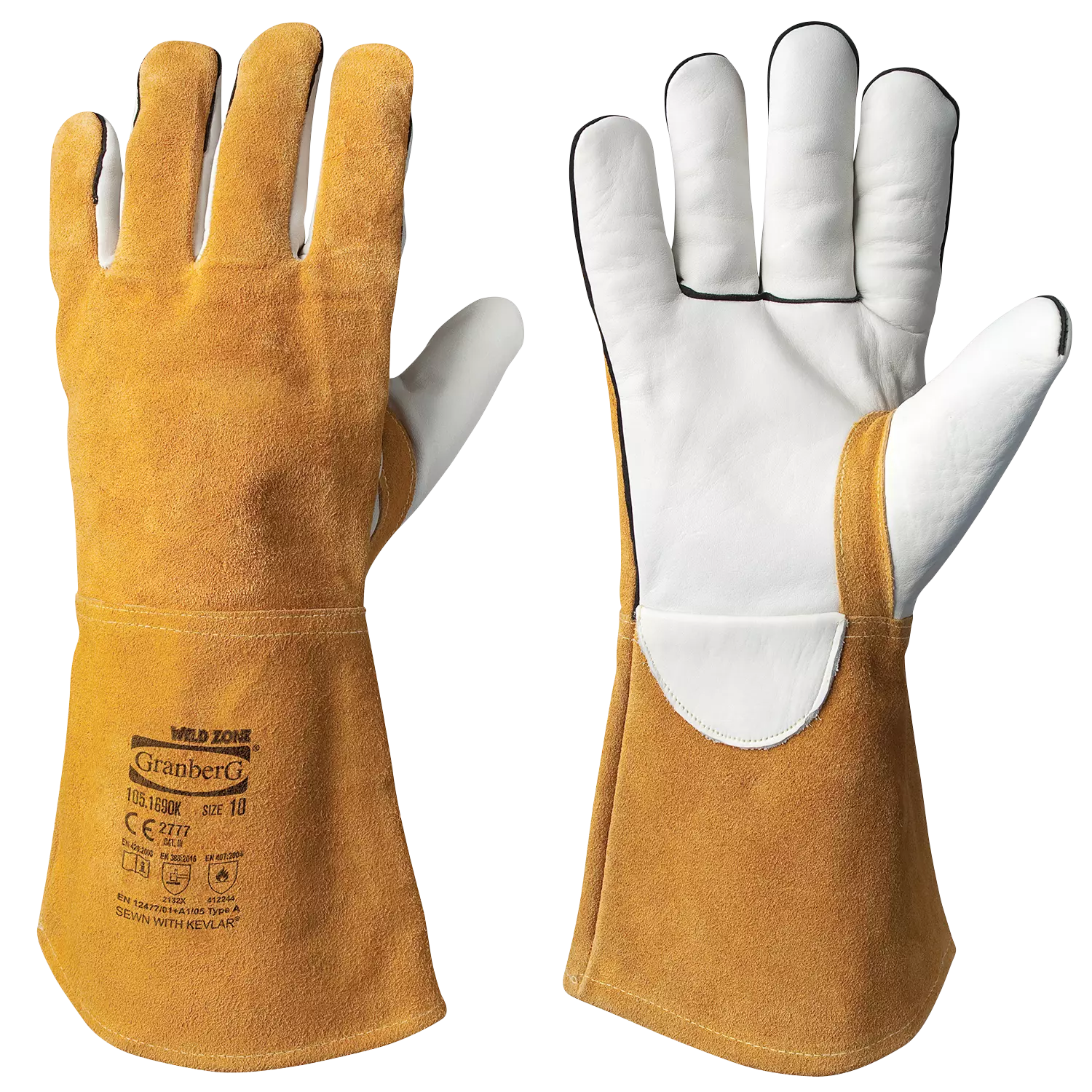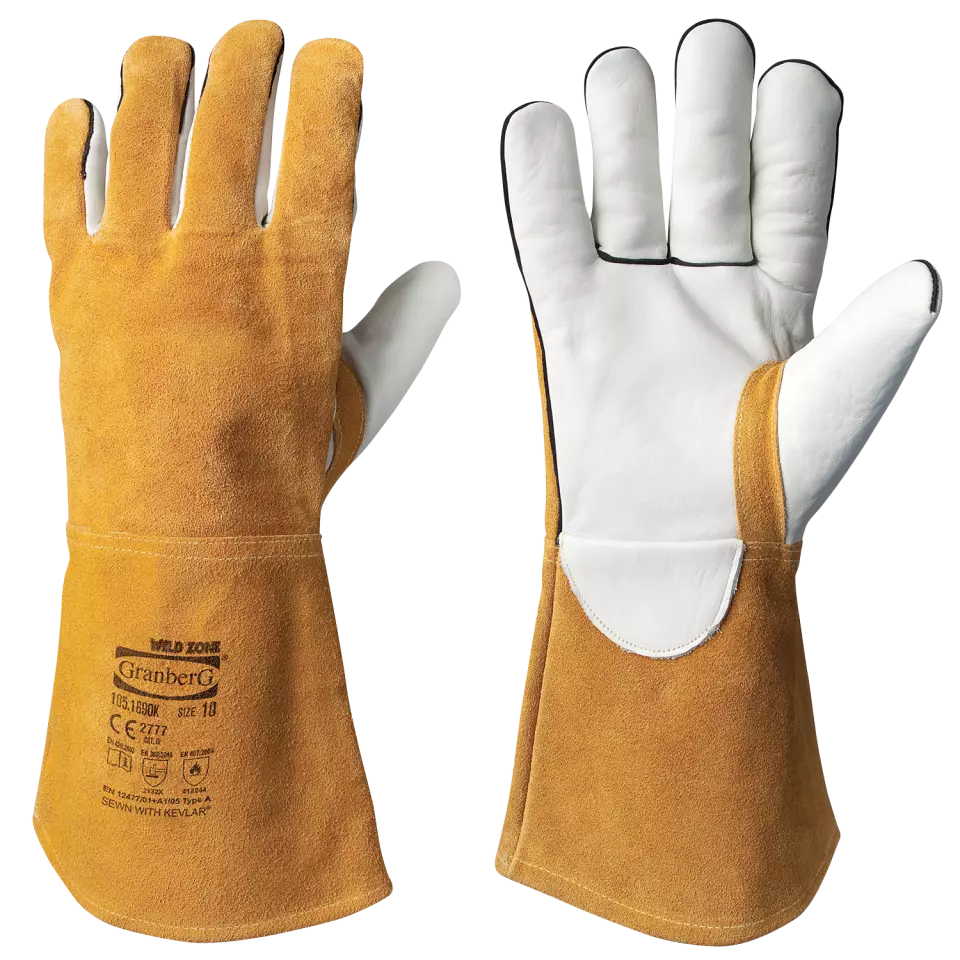
Features You'll Love

Palm Material · Cowhide Leather
The material used on the palm side of the glove, affecting grip, durability, protection level, and comfort during use.

EN 388 · Abrasion Resistance Level 2, Tear Resistance Level 3, Puncture Resistance Level 2
EN 407 · Burning Behaviour Level 4, Heat Contact Level 1, Heat Convection Level 2, Metal Splash Resistance Level 4
Withstands moderate rubbing and friction, offering good protection for tasks involving handling rough materials.
Offers strong resistance against ripping, making the material durable against snags and tears.
Withstands moderate force from sharp objects like heavy-duty splinters or wires.
Provides the highest level of protection against catching fire when exposed to a naked flame. After the flame is removed, the material will stop burning within 2 seconds and stop glowing within 5 seconds.
Provides protection when briefly touching hot objects. Certified for contact with surfaces up to 100°C for at least 15 seconds, offering short-term protection against burns from items like hot cookware or machinery parts.
Provides moderate protection by delaying heat transfer from an open flame. Ideal for tasks where hands are near, but not touching, a flame, giving you more time to move away safely from the heat source.
Provides the highest level of protection against large splashes of molten metal, tested to resist amounts greater than 200 grams. This makes it essential for high-risk industrial jobs like foundry work and heavy welding.
Granberg
Welder’s Gloves, Size 10, White/Brown, 6 pairs
Welder’s Gloves, Size 10, White/Brown, 6 pairs
4.7 / 5
63,40 €
Price per 6 pairs
10,57 € / pair
Choose size
Free delivery
Features You'll Love

Palm Material · Cowhide Leather
The material used on the palm side of the glove, affecting grip, durability, protection level, and comfort during use.

EN 388 · Abrasion Resistance Level 2, Tear Resistance Level 3, Puncture Resistance Level 2
EN 407 · Burning Behaviour Level 4, Heat Contact Level 1, Heat Convection Level 2, Metal Splash Resistance Level 4
Withstands moderate rubbing and friction, offering good protection for tasks involving handling rough materials.
Offers strong resistance against ripping, making the material durable against snags and tears.
Withstands moderate force from sharp objects like heavy-duty splinters or wires.
Provides the highest level of protection against catching fire when exposed to a naked flame. After the flame is removed, the material will stop burning within 2 seconds and stop glowing within 5 seconds.
Provides protection when briefly touching hot objects. Certified for contact with surfaces up to 100°C for at least 15 seconds, offering short-term protection against burns from items like hot cookware or machinery parts.
Provides moderate protection by delaying heat transfer from an open flame. Ideal for tasks where hands are near, but not touching, a flame, giving you more time to move away safely from the heat source.
Provides the highest level of protection against large splashes of molten metal, tested to resist amounts greater than 200 grams. This makes it essential for high-risk industrial jobs like foundry work and heavy welding.
Product description
Premium welding gloves crafted from A-grade cow grain leather featuring full cotton fleece lining for superior comfort and protection. Reinforced thumb base and heat-resistant Kevlar® thread construction ensure exceptional durability during demanding welding operations. The 35cm length and 1.2-1.4mm thickness provide comprehensive protection against heat, sparks, and molten metal splashes.
Product Features:
- Full cotton fleece lining for comfort
- Thumb base reinforcement
- Heat-resistant Kevlar® thread construction
- Loose fit design
- Dry grip optimization
Technical Details:
- Length: 35 cm
- Thickness: 1.2-1.4 mm
- Back material: Cow split leather
- Palm material: Cow grain leather
- Liner: Cotton fleece
Protection Ratings:
- Abrasion resistance: Level 2
- Tear resistance: Level 3
- Puncture resistance: Level 2
- Fire properties: Level 4
- Molten metal splash resistance: Level 4
- Large quantities molten metal: Level 2
- Contact heat: Level 1
- Convective heat: Level 2
- Radiant heat: Level 1
Standards:
- CE Category II certified
- EN 12477:2001 Type A
- EN 11492-2
- EN 420:2003+A1:2009
- UKCA compliant
Recommended Applications:
- Welding operations with steel
- Aluminum welding
- General metal welding applications